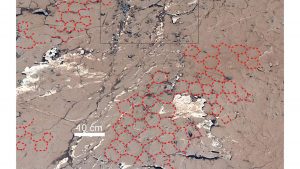A team of researchers at Indiana University and NASA have uncovered the first tangible evidence for sustained wet-dry evolution on Mars, which is considered essential for prebiotic chemical evolution, a stepping-stone towards the emergence of life.
The team analysed data from NASA’s Curiosity Rover to understand biological evolution on Mars.
The rover currently explores Gale Crater to examine the ancient pattern of mud cracks filled with salt (geometric patterns like pentagons or hexagons) observed in 3.6 billion-year-old mudstones.
The paper, ‘Sustained wet-dry cycling on early Mars,’ is published in Nature.
Biological evolution on Mars is currently a mystery
Mars’ habitable surface environments early in its existence have been firmly established by the scientific community.
These environments provided water, energy sources, elements like carbon, hydrogen, nitrogen, oxygen, phosphorus, and sulphur, as well as critical catalytic transition metals associated with life as we know it.
However, whether that potential stimulated further progression towards independent evolution on Mars is unknown.
Sustained wet-dry cycling on Mars – a consequence of repeated desiccation, recharge, and flooding – creates cracks in the lake bed. Within those cracks, high salt concentrations develop that force the crystallisation of minerals left after the lake’s evaporation and cementation of sediment.
Ultimately this process was preserved as the polygonal (hexagon- or pentagon-shaped) patterns observed with the Rover. Due to desiccation, the residual water likely had high concentrations of dissolved salts and, potentially, organic molecules that can serve as the building blocks of evolution on Mars.

The role of wet-dry cycling in discovering life on Mars
“The theory is, that as these elements and organic molecules are forced closer and closer together with increasing salinity, they may start polymerising and make longer chains, creating the conditions for spontaneous chemistry that may start the complex chemical evolution that could lead to living organisms,” explained Professor Juergen Schieber, from the Department of Earth and Atmospheric Sciences at Indiana University.
He added: “It is that mental image that got us excited when we observed these honeycomb-shaped, or polygonal, ridge patterns on the surface of mudstone beds. Here was evidence for wetting and drying that could drive interesting chemistry within the cracks.”
Knowing from earlier studies that likely residuals from the lake’s desiccation should be calcium and magnesium sulphate minerals, the team used the ‘Chemcam’ instrument on the Curiosity Rover to probe the cemented ridges to confirm their theory about evolution on Mars.
The sedimentary features of the mudstones studied can be interpreted to have resulted from multiple wetting and drying cycles resulting in mineral precipitates on top of each other over time.
If organic molecules were present in residual brines, this setting may have been conducive to the evolution of Mars. The study reported that more complex organic molecules and pre-biotic chemistry could have evolved from this process.









